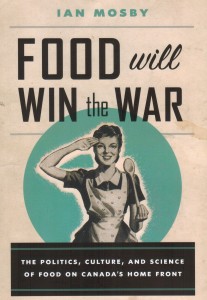To read this delightful account of wartime eating is to comprehend for the first time our mothers’ odd fascination with liver.
Livestock organs have today vanished from most supermarkets including items that butchers once creatively marketed as “variety meats”: calves’ brains, tongue, tripe and kidneys. None blighted so many childhoods as liver: liver loaf, minced liver, liver sauté, and most appalling, fried liver and onions, a dense, grey, mealy dish that could only be choked down with ketchup.
“Eat liver frequently” was the decree of the 1944 Official Food Rules. An entire generation of homemakers took the admonishment to heart long after victory was ours.
Food Will Win The War is a fresh and lively account of the Canadian dinner plate. It peers into the corners of the historical cupboard to uncover the most intriguing details of the home front experience. Researchers rarely delve into diet in documenting the past, though the results are always revealing. Who is not wiser on learning Lester Pearson’s favourite lunch was a poached egg? Or that Britain’s Ministry of Food decreed rice soup with haddock as Christmas Day supper in 1917?
Historian Ian Mosby tells us what the war tasted like. It was plain but filling. “In part this was achieved through unprecedented state intervention in Canadian food production,” Mosby writes. “The federal government had taken direct control over the bulk purchase, sale and distribution of a range of basic commodities – including sugar, tea, coffee, wheat and rice.”
The food czar who led the Wartime Prices and Trade Board was Donald Gordon, a no-nonsense executive who later ran Canadian National Railways. Gordon was a plain eater himself. His favourite dessert was a toothpaste-like gelatin called Mint Bavarian. He was just the man for the hour.
Canada was never short of food. The average family ate better during the war than they had in the Depression. But the nation had to literally feed an army and Allies, too.
The country supplied 77 percent of Britain’s wheat and flour by 1941. Gordon’s board printed Food Guide posters telling Canadians what they should eat to help the troops. The Guide depicted “anthropomorphic foodstuffs marching with rifles,” Mosby notes. “Feeding one’s family according to the newly created Canada’s Official Food Rules emerged as a mother’s wartime duty, while reporting the baker to the authorities for selling a loaf of Canada’s Approved Vitamin B Bread above its ceiling price became an important patriotic act.”
This is what the country ate in 1944: two cups of milk daily, one tomato, one apple, one serving of potatoes, two servings of green vegetables preferably raw, one serving of whole grain cereal, four slices of bread with butter, one serving of meat, fish or eggs, one serving of cheese or nuts, “liver frequently”. Note the omissions: no soda; no pizza; no frozen dinners that marked the dawn of postwar cookery in the 1950s.
Food was rationed from 1942 but the guidelines were generous: half a pound of butter per person per week, half a pound of sugar, half a pound of coffee, 2 and a half pounds of meat. By comparison the meat ration in Nazi-occupied France was one-seventh the Canadian ration, Mosby writes. The country ate so well that meat production reached an all-time high in 1943.
Including liver, with onions.
By Holly Doan
Food Will Win The War: The Politics, Culture and Science of Food on Canada’s Home Front, by Ian Mosby; University of British Columbia Press; 288 pages; ISBN 9780-7748-27614






